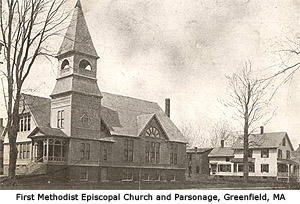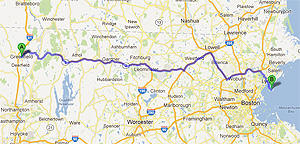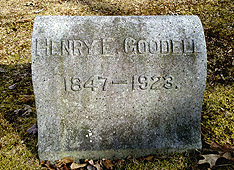The second child, Josephine M. Goodell, was a graduate of
a High School in
Shelburne. In August, 1900 the Greenfield Recorder
announced her engagement to Perley E. Fay and on October 10,
1900, they were married.
“The marriage of Miss Josephine May
Goodell, only daughter of Mr. and Mrs. Henry E. Goodell of
Main Street and Perley Everett Fay, son of S. E. Fay of
Athol, was solemnized at the residence of the bride's
parents at 2 o'clock this afternoon. Rev. W. C. Townsend of the Methodist
Episcopal Church performed the ceremony with the abbreviated
Episcopal service, using the ring, under an arch of green.
The floral decorations were beautiful and consisted of
potted plants and cut flowers. The bride looked
charming in a gown of Swiss muslin over white silk and
carried bride roses. The bridesmaid was Miss. Helen E.
Goodell of Shelburne Falls, a cousin of the bride (a
daughter of Albert D. Goodell). She was handsomely attired
in a gown of white organdie and carried carnations. E.
Warren Tyler of Athol acted as best man."
Henry E. Goodell was in every way a self-made businessman.
He was not
inclined to join high society circles and preferred
a simple life. He was known to be a humble man and preferred
to limit his social life to his church and family.
Whenever needed, he was generous and charitable.
Here is an excerpt from report
on events at First Methodist Episcopal Church published by
Greenfield Gazette and Courier, March 7, 1903:
 ""During the year the church
has been moved, electric lights put in, the walls frescoed,
a now chimney parsonage has been moved and raised up, giving
room for a fine basement, on the bottom of which a cement
floor has been laid. The
valuation of the church property is now $3000 for the
parsonage and $10,000 for the church.
""During the year the church
has been moved, electric lights put in, the walls frescoed,
a now chimney parsonage has been moved and raised up, giving
room for a fine basement, on the bottom of which a cement
floor has been laid. The
valuation of the church property is now $3000 for the
parsonage and $10,000 for the church.
At the business meeting,
resolutions thanking F. A. Pond and Henry E. Goodell for
their generosity in connection with the moving of the church
were passed."
Seven years later the church needed
additional remodeling and after its completion the Greenfield
Gazette and Courier reported on December 3, 1910:
"The First Methodist
Episcopal Church has been greatly improved and modernized by
changes just being completed. An addition, 24x12, has
been made to the north end of the building, and the pulpit
is moved to this side, the seats turned around, and the
choir and organ go behind the pulpit. New seats can thus be put in
accommodating 75, making the total capacity of the main
audience room 400. The old opera chairs are taken out and
there are new pews of old English oak. Henry E. Goodell was chairman of the building
committee that had charge of the new work, and he has
personally paid the bills."
In 1913 the First Methodist
Episcopal Church celebrated re-dedication and more details were
revealed by the Greenfield press:
“At the close of the sermon
the bishop called the board of trustees of the church to
come forward to the front of the church, and the president
of the board, Mr. Goodell, presented the keys of the church
to the bishop.
A few years ago it became
necessary to move the church in order to permit, the
widening of Franklin Street and since that time many
alterations and improvements have been made, chief of which
were a remodeled church and an entirely new parsonage. The
work on the buildings has been done at an expense of
$25,000, the greater part of which has been born by one
member, Henry E. Goodell of Greenfield. The officers
and members of the church believe that they have one of the
most commodious and beautiful churches and parsonages in
western Massachusetts, and they are especially grateful to
Mr. Goodell for his generosity, in making all this
possible." (35)
Henry E. Goodell was described as
"a
man of much stability of purpose and integrity, and by his
untiring energy and enterprise has reached his present place
among the successful men of the period." (36)
I believe it is an accurate description and
reflection of his character. I am especially impressed with
the stability
and strength of his
commitment. Somewhat overshadowed by his older brother
Albert D., he appeared to be firmly committed to the business
they both started, the Goodell Brothers. Even after
Albert’s departure he did not change the name of the business,
which he could have done and renamed it after himself.
Despite separation with Albert D., Henry
E. decided to continue the business, expend it and lift it up to a
higher level. He moved to Greenfield, MA and invested, most
likely, a major portion of his assets into building the new factory and
making it as modern as possible. He didn’t hesitate to
bring along his other brother, Dexter W., and share with him an
opportunity to build the business.
With all that, it seems that he didn’t let his
ego blind him. It soon became apparent to Henry E. that in
order to make his company valuable, capable to compete and
assure successful existence, he would need help. I think he clearly realized his weaknesses and
strengths, and decided to deal with them.
I believe this is why he brought William M.
Pratt into the company and didn’t hesitate to give him
the responsibility for finances, marketing and sales. With
that, he eagerly focused himself on the area where his skills
were most productive – new tools design and production. He
assumed position of the company president and superintendent and
took the work into his hands.
Within two years the Goodell
Brothers Co. patented, designed and built an impressive number of new
tools and put them on the market. In his dealings he
appeared to be humble, realistic, but also firm. Even
after his departure, he assured that the name “Goodell” would be
preserved in the industrial history. Not only the name Goodell
Brothers was not change after company incorporation, but even
after his complete departure, the new company preserved its
roots in a new name – Goodell-Pratt Company.
Patents received by Henry E. Goodell
Henry E. enjoyed work and the industry he has
been with from the beginning of his professional life.
After the departure from Goodell Brothers Co. he started other
businesses and continued to offer his best – new tools and their best
implementation.
 On
rare occasions Henry E. took time off from work. In July,
1913, he took one of the more interesting and ambitious trips.
The whole family, including Henry's wife Alice, his daughter
Josephine and her husband Perley E. Fay went to Nahant, MA, for
ten days, making a trip by car!(37)
On
rare occasions Henry E. took time off from work. In July,
1913, he took one of the more interesting and ambitious trips.
The whole family, including Henry's wife Alice, his daughter
Josephine and her husband Perley E. Fay went to Nahant, MA, for
ten days, making a trip by car!(37)
By 1916 Henry E. Goodell had retired for good. He
was dealing with declining health for some time already and
needed to take increased time for rest. In 1917 he became
seriously ill, but recovered after a stay in hospital.
At the beginning of February, 1923, Henry E. Goodell
contracted severe case of pneumonia and after two week he passed away.
He was buried in Green River cemetery, Greenfield MA.
 "Henry E. Goodell, for many years a
manufacturer of tools and hardware specialties, died in his
home in Greenfield, Mass., Feb. 23, at the age of 77 years.
He was born in Whitingham, Vt. With Albert D. Goodell he
engaged in the manufacture of hardware under the name of
Goodell Bros, at Shelburne Falls and Greenfield, and in 1893
founded the establishment now conducted as the Goodell-Pratt
Company." (38)
"Henry E. Goodell, for many years a
manufacturer of tools and hardware specialties, died in his
home in Greenfield, Mass., Feb. 23, at the age of 77 years.
He was born in Whitingham, Vt. With Albert D. Goodell he
engaged in the manufacture of hardware under the name of
Goodell Bros, at Shelburne Falls and Greenfield, and in 1893
founded the establishment now conducted as the Goodell-Pratt
Company." (38)